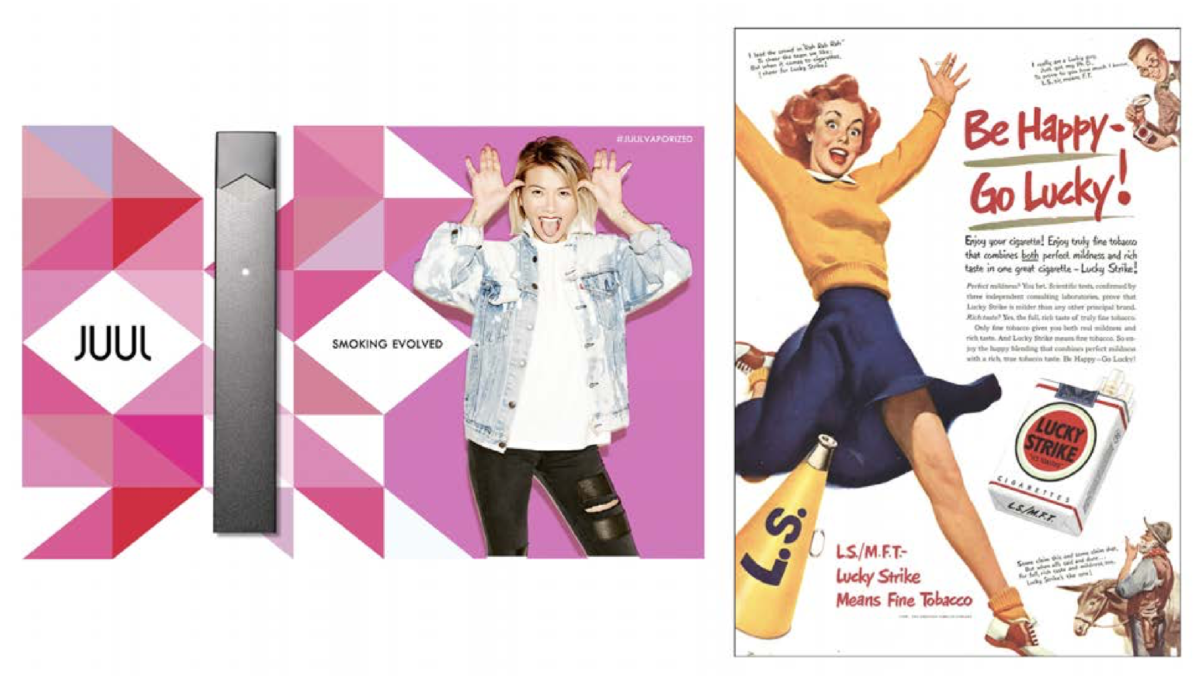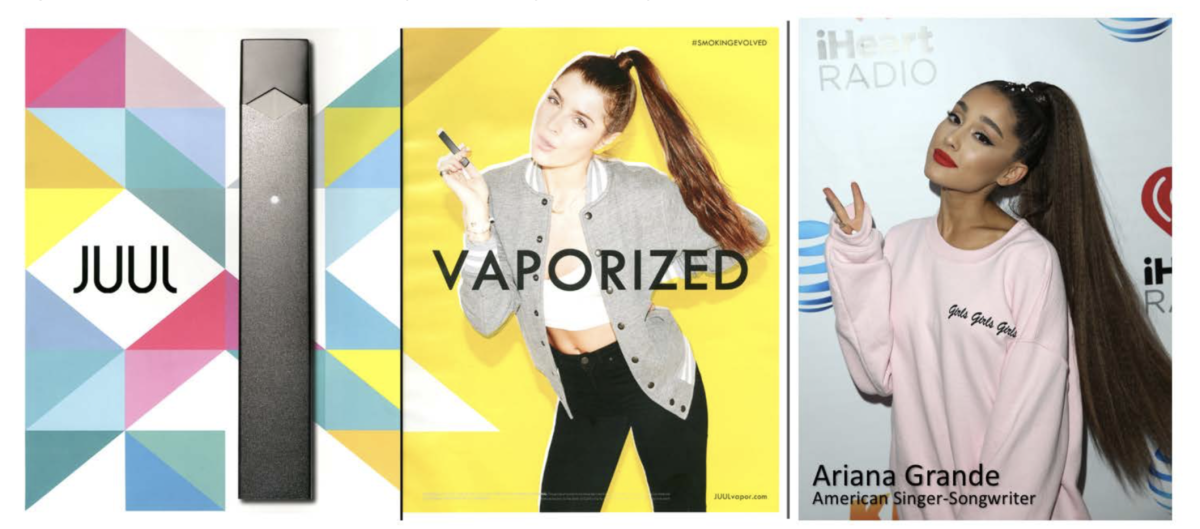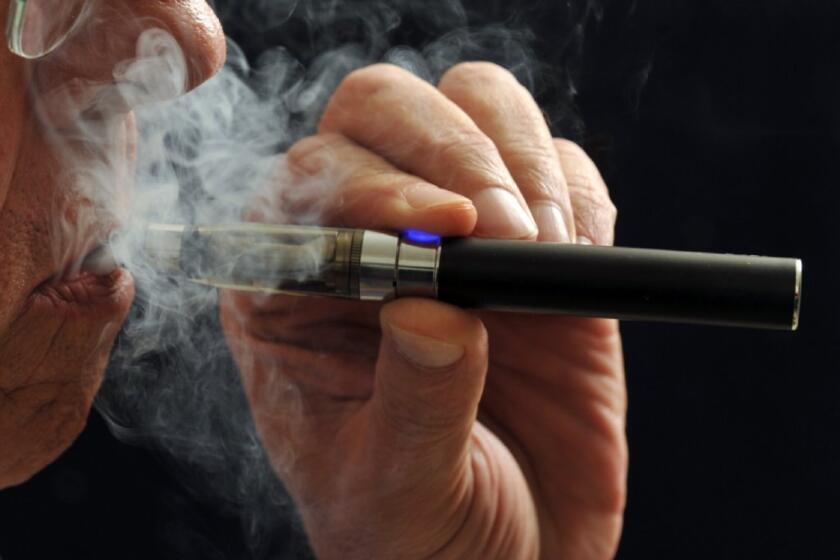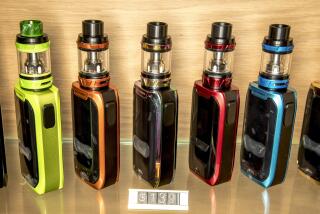Column: Studies show how Juul exploited social media to get teens to start vaping

Juul Labs, the leading e-cigarette maker, says it has long been upfront about its determination to keep young people away from its vaping products.
That’s what the San Francisco company says, anyway. But its advertising strategy has assiduously cultivated young consumers, with great success.
That’s the finding in a series of studies from Stanford University that have turned a spotlight on how Juul exploited social media and the tastes of young adults to target a youth market.
Social media has been a central factor in establishing Juul as a fad among teens.
— Stanford study of Juul ads
Juul’s “repeated assertion that their product is meant for ‘adult smokers only’ has not been congruent with its marketing practices over its first three years,” said a study published in January by a Stanford program researching the impact of tobacco advertising. For close to a year after the company’s product launch in mid-2015, its advertising “featured patently youth-oriented imagery and messaging.” (Hat tip to Kevin Drum.)
The thrust of Juul’s advertising has evolved since then, largely in an attempt to stave off regulatory and legislative attacks, but the impact continues. After the company halted its promotional social media postings in November 2018, according to a Stanford study published in July, online posts using the hashtag #Juul actually doubled.
The posts typically originated within a community of youthful users that had coalesced around the company’s earlier advertising and had taken on momentum of its own. The Stanford papers were based on assiduous collecting of Juul ads and marketing materials.
“They knew what was going on, and they did nothing to stop it,” says Robert K. Jackler, a professor at Stanford Medical School and head of the Stanford program.
Juul denies that its ads ever were aimed at a young audience. “We have never marketed to youth and we never will,” the company told me by email. “Our marketing efforts exclusively feature adult smokers who share their personal experiences about switching to Juul products from combustible cigarettes — all conveyed in a style, tone and message tailored to current adult smokers.”
Ever since their retail introduction about a dozen years ago, e-cigarettes have been at the center of a debate over their impact on public health.
Juul’s role in fostering vaping among adolescents and young adults has come under the spotlight because of growing alarm over the rapid increase in vaping among those age groups. A University of Michigan study of drug abuse trends published in December reported that “increases in adolescent vaping from 2017 to 2018 were the largest ever recorded in the past 43 years for any adolescent substance use outcome in the U.S.”
The recent outbreak of lung diseases among vaping users has focused public attention on the practice as never before. More than 500 cases of lung injury have been reported from 38 states, according to the Centers for Disease Control and Prevention, mostly associated with vaping of products containing THC, the active chemical in cannabis. The CDC says it has received confirmed reports of seven deaths in six states. It says it hasn’t been able to link the outbreak to any specific product.

Jackler says the long-term impact of vaping is what should be garnering public concern. “The way to keep from having a population of adult smokers in America is to keep young people from starting in the first place,” he told me. “Smoking initiation is almost entirely an adolescent thing. It’s something teenagers do, and the industry knows that. The ‘new adopters’ of Juul are teenagers. They like new technology, they like flavors — it was perfectly positioned to grab hold of a youthful audience.
That brings us back to Juul’s advertising. At first it seemed tailored for a younger audience, showing twentysomethings cavorting playfully in social settings — a subtle appeal to teenagers’ desire to see themselves as young adults.
“If you’re aiming your product to transition smokers over to something newer and purportedly safer, you’re going to advertise in a way that it appears to people in the age range of 30 to 60, because most smokers fall into that range,” Jackler says. “But their advertising was calibrated to appeal to a much younger demographic than the audience they claimed to be appealing to.”
Juul says its launch campaign, “Vaporized,” “was intended for adult smokers, ages 25-34,” though “we recognize how that campaign was perceived.” The campaign was ended after six months.
E-cigarettes, those battery-powered nicotine vapor delivery systems that are infiltrating the airwaves, schoolyards, and public spaces, are threatening to undo a decades-long campaign to stigmatize smoking.
After that, Jackler says, Juul began “to temper their advertising so it became very similar to traditional tobacco advertising.” Its ads associated the product more with grown-up pleasure, relaxation, romance and glamour. But they were advertising not on channels followed by older adults such as magazines, newspapers and broadcast TV, but “through organic social media marketing on channels heavily frequented by young people, and it became viral.”
It used terminology such as “satisfaction,” which has “long been used by tobacco advertisers as a proxy for satisfying one’s craving driven by nicotine addiction.” Like cigarette ads, Juul’s advertising featured “attractive young women in suggestive poses,” “playfully arranged groups of young people” at parties or social outings and couples enjoying a romantic smoke.
Even more recently, the company shifted to a marketing campaign aimed at portraying its products as safer than cigarettes, ostensibly to provide older smokers with an incentive to switch. But that campaign got Juul, which was already under scrutiny by the Food and Drug Administration for its marketing practices, into more hot water with the FDA. That’s because it’s illegal to claim that a product is safer than tobacco without an FDA order issued after a review of “scientific evidence.” The FDA advised Juul to knock it off via a warning letter issued Sept. 9.
One oft-noted marketing technique is the use of flavorings, some of which appeal to youthful palates. In June, San Francisco voters opted to ban the sale of flavored cigarettes and vaping products. And this month, the Trump administration floated a plan by the FDA to ban all e-cigarettes except those that taste like tobacco.

Juul has restricted the distribution of its sweetest flavors to online sales only, ostensibly because it can exercise more control over the consumer base, but the Stanford researchers say “the demarcation line is unsupportable” between those it does sell, whether online or in stores, and the ultra-sweet flavors it avoids entirely. Young smokers barred from purchasing flavors such as mango and creme appear to be shifting to mint and menthol, which are openly available, according to data cited by Alex Azar, secretary of Health and Human Services.
Jackler says social media platforms popular among teens, such as Instagram, and Juul itself should take more aggressive steps to shut down use of the #Juul hashtag and thus end the viral peer-to-peer marketing that keeps the brand popular in the youth market. Instagram generally has the right to take down posts that it believes infringe on a trademark, and Juul could seek takedown orders on its own, given that “social media has been a central factor in establishing Juul as a fad among teens,” as Stanford’s July study put it.
Juul says it “routinely submits takedown requests based on trademark infringement for Instagram posts that ... misleadingly promote the sale of counterfeits, compatibles, diverted Juul product, accessories, and competitor products.” But its pursuit of those posts “does not extend to any and every use of #juul, including otherwise problematic social postings, commentary or criticism about the company.” The company said that it supports Instagram’s banning the hashtag #Juul “and implementing enhanced community standards to address inappropriate vaping content targeted at youth.”
Juul says campaigns against all posts using the #juul hashtag “are not viable solutions — either legally or practically — to the serious problem we face.” That leaves the question of whether Juul will be part of the solution, or continue to be part of the problem.









